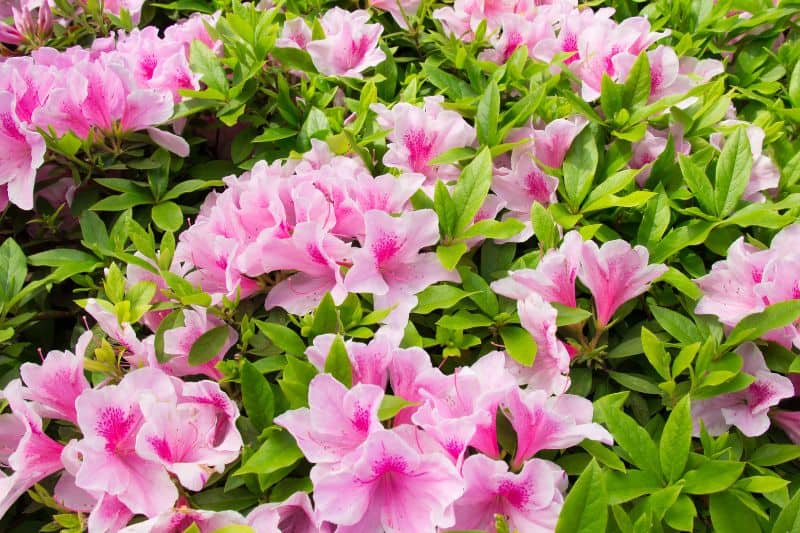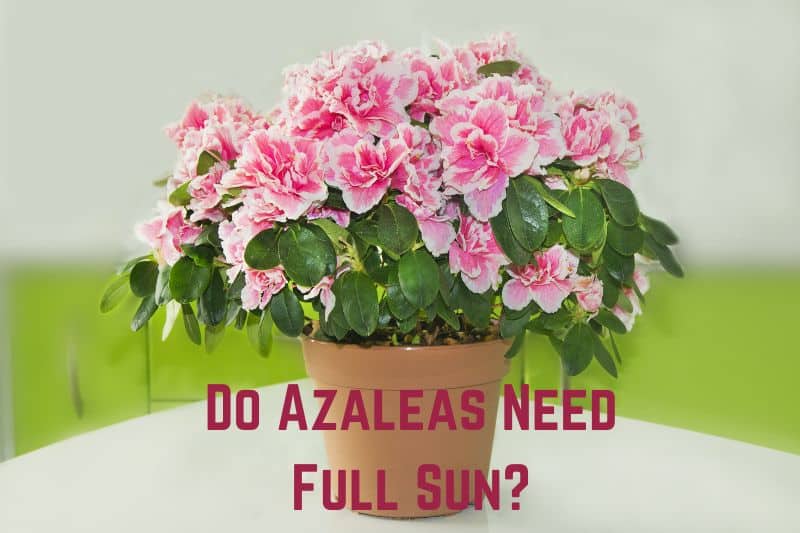Azaleas are among the most beloved and iconic flowering shrubs, with vibrant blooms and elegant foliage. These stunning plants are native to several regions worldwide, including Asia, Europe, and North America.
They are famous for their showy and colorful flowers in various hues, including shades of pink, purple, white, and red. Azaleas are often associated with springtime, as they typically burst into full bloom during this season, creating a breathtaking display of color.
What makes azaleas even more remarkable is their ability to thrive in various environments, from woodland gardens to container plantings. Azaleas do not require full sun. They prefer acidic soil and partial shade, although some varieties can tolerate more sun exposure.
Read: Do Hydrangea Need Full Sun or Shade?
Do Azaleas Need Full Sun or Shade?
Azaleas are beautiful flowering shrubs that come in a variety of colors and sizes. One of the great advantages of growing azaleas is their versatility. They can be grown as striking standalone plants, used as borders or hedges, or even planted in containers for a beautiful patio display.
Ideally, they should receive four to six hours of sunlight per day. Morning sunlight is especially beneficial for your azaleas as it’s usually not as intense as the afternoon sun. Providing your azaleas with some shade in the afternoon can also help prevent the flowers and leaves from scorching, especially during hotter summer months.
To achieve the perfect sunlight balance for your azaleas, consider planting them in areas with dappled shade provided by nearby trees or taller shrubs. This will allow your plants to receive indirect sunlight, protecting them from overly harsh rays while still meeting their light requirements.
While azaleas can still survive in shadier conditions, it’s important to note that they may not produce as many blooms or experience slower growth. However, excessive sunlight can cause your azalea shrubs to struggle with drought stress and scorching, so be cautious not to provide too much sun.
Can Azaleas Get Too Much Sun?
Azaleas can get too much sun. To protect your azaleas from excessive sun exposure, there are a few steps you can take when planting them.
Firstly, it’s crucial to choose a suitable location for your azaleas. Look for an area in your garden that receives filtered or partial shade for at least part of the day.
You can achieve this by planting them near trees or taller shrubs that can provide some shade. Additionally, consider the direction of the sun. Planting your azaleas on the east or north side of your house or near a fence or wall can offer protection from the hot afternoon sun.
Another helpful technique is to prepare the soil properly. Azaleas thrive in well-draining, acidic soil, so amend the soil with organic matter such as compost or peat moss to improve drainage and ensure an acidic pH level. This will help the plants better tolerate sun exposure.
Furthermore, consider mulching around your azaleas. Apply a layer of organic mulch, such as wood chips or pine needles, around the base of the plants. This will help retain moisture in the soil and keep the roots cool. Just be sure to keep the mulch a few inches away from the stems of the azaleas to prevent rotting.
Lastly, regular watering is essential for azaleas, especially during hot and dry periods. Water deeply but infrequently, allowing the soil to dry out slightly between waterings. This will encourage the roots to grow deeper and more resilient to drought conditions.
By following these tips and providing some shade, well-draining soil, mulch, and proper watering, you can help protect your azaleas from excessive sun and create an environment where they can thrive.

Can Azaleas Grow in Full Shade?
Azaleas can grow in full shade, but their growth and flowering may be affected. While they are shade-tolerant plants, they flourish in areas with dappled sunlight or partial shade. Generally, azaleas require at least 4-6 hours of indirect sunlight during the day to ensure optimal growth and blooming.
In full shade, you may notice that your azaleas grow slower and produce fewer flowers. Besides, the foliage may appear less vibrant, and the plant may become more susceptible to pests and diseases.
Providing the right care is crucial to keep your azaleas healthy in a full shade environment. Some tips to help your azaleas thrive in full shade include:
- Ensure proper soil conditions: Azaleas prefer well-draining, slightly acidic soil with a pH between 5.5 and 6.0. Adding organic matter like compost or peat moss can help improve soil quality and create a suitable environment for your plants.
- Water them consistently: Azaleas need consistent moisture, especially in shaded areas with less evaporation. Ensure to water them regularly, keeping the soil evenly moist but not soggy. Overwatering can harm them, so be cautious.
- Prune after blooming: Regular pruning helps maintain your azaleas’ shape and encourages new growth. It’s best to prune immediately after they finish flowering to avoid cutting off next year’s buds.
- Monitor for pests and diseases: Since full shade conditions may make your azaleas more susceptible to them, check them regularly. Prompt action can prevent further damage if you spot any issues.
In conclusion, while azaleas can grow in full shade, they perform better with some sunlight. Consider planting your azaleas in an area with dappled or filtered light to provide them with the best conditions possible.
Types of Azaleas and Sunlight Preferences
When it comes to azaleas, it’s important to know their sunlight preferences to help them thrive in your garden. There are two main types of azaleas: deciduous and evergreen. Each type has its own requirements when it comes to sunlight and shade.
Deciduous azaleas are known for losing their leaves in the fall, leaving behind a beautiful array of bare branches during winter. These types of azaleas generally enjoy the following sunlight conditions:
- Partial shade: Deciduous azaleas benefit from dappled sunlight during the day. Placing them under a canopy of taller trees or near taller shrubs will provide them with the protection they need from harsh, direct sunlight.
- Morning sun: These azaleas prefer receiving sunlight in the morning, as they can better tolerate the cooler temperatures and less intense rays. It’s best to position them in a spot where they can soak up the morning light while remaining shaded throughout the hotter afternoon hours.
On the other hand, Evergreen azaleas are characterized by their ability to retain their leaves year-round. They make an excellent choice for adding color to your garden throughout all seasons. These azaleas typically favor the following sunlight conditions:
- Filtered sunlight: Evergreen azaleas can handle a bit more sun than their deciduous counterparts but still require some protection. Filtered sunlight through tree branches or placing them in a partially shady spot will help maintain their vibrant foliage.
- Bright indirect light: These azaleas will thrive in areas where they receive plenty of bright, indirect light. This can be achieved through dappled sunlight or by placing them in a spot that receives reflected light from a nearby structure.
When planning where to plant your azaleas, remember that many different species and cultivars are available, each with their own specific light requirements.
Generally, regardless of the type of azalea, avoid locations that receive intense, direct afternoon sunlight. This could lead to scorched leaves, reduced flowering, and other damage. Instead, opt for locations with morning sun, filtered light, or bright indirect light, depending on the specific preferences of your chosen azalea.
Signs Your Azaleas Are in Too Much Sun
If you’re growing azaleas, you might wonder if they’re getting the right amount of sunlight. While these beautiful plants love bright environments, too much sun exposure can be harmful. Here are some signs that your azaleas might be getting too much sun:
Leaf scorch: If your azalea’s leaves appear brown, dry, or crispy at the edges, this is often a sign of sunburn. The plant may be getting more direct sunlight than it can handle. Consider moving it to a location with more shade, especially during the hottest parts of the day.
Fading or sun-bleached blossoms: Azaleas are known for their vibrant blooms. However, too much sun exposure can cause their stunning colors to fade or appear bleached. Ensure that the plant gets a few hours of morning sun, but has protection from the intense afternoon rays.
Wilting during the day: If your azalea starts wilting while the sun is high, this might be a sign that it is struggling with too much sunlight. Monitor the plant and water more during hot days. However, if wilting persists, it’s time to rethink its placement in your garden.
Stunted growth: Achieving the perfect balance between sun exposure and plant growth can sometimes be challenging. If your azalea grows very slowly or not at all, it might receive too much sun. Experiment by moving the plant to a shadier spot and watch for new growth.
Aim for a location that provides dappled light or morning sun exposure to keep your azaleas healthy and happy. With just the right amount of sunlight, your azaleas should continue to grace your garden with their stunning beauty.

Ideal Growing Conditions for Azaleas
Lighting Conditions
Azaleas are versatile plants that can thrive in various lighting conditions. However, they do not need full sun to grow well. They prefer partial shade with dappled sunlight filtering through the foliage of taller trees.
A good rule of thumb is to provide your azaleas with 4-6 hours of filtered sunlight daily. Too much direct sun can cause scorching and damage the delicate leaves and blooms.
Soil Requirements
When it comes to soil, azaleas have specific requirements for healthy growth. They thrive in well-draining, acidic soil with a pH between 4.5 and 6.0. Here are some quick tips to create the right soil conditions for your azaleas:
- Use a soil mixture that contains peat moss, pine bark, or other organic materials to improve drainage and retain moisture.
- Fertilize with a slow-release, acid-forming fertilizer formulated for acid-loving plants like azaleas.
- Mulch with pine needles, bark, or shredded leaves to conserve moisture and maintain the right acidity level in the soil.
- Monitor the soil’s pH level regularly and adjust with soil amendments like sulfur or lime as needed.
Remember that healthy soil leads to healthy plants. You can enjoy beautiful blooms and thriving plants for many years by providing your azaleas with the right lighting conditions and soil requirements.
Read: Does Lemongrass Need Full Sun? (Answered)
How To Protect Azaleas From Excessive Sunlight?
Azaleas can thrive in various sunlight conditions, but too much direct sun can damage their beautiful blooms and leaves. In this section, you’ll learn how to protect your azaleas from excessive sunlight through shade nets and suitable mulch.
Use of Shade Nets
Shade nets are a great way to protect your azaleas from the harsh effects of direct sunlight. To safeguard your plants, follow these steps:
- Choose a suitable net: Opt for a shade net that blocks 30-50% of sunlight. This will ensure your azaleas receive adequate light without being overwhelmed.
- Install the net: Erect support structures around your azalea plants, such as poles or stakes. Attach the shade net to these supports to create a canopy that covers your plants. Ensure the net is secure and has sufficient tension to prevent sagging.
- Monitor the plants: Keep an eye on your azaleas to ensure they’re not suffering from too little sunlight. Adjust the shade net as needed, or remove it during periods of low light to allow your plants to receive the optimal amount of sunlight.
Using Suitable Mulch
Applying an appropriate layer of mulch around your azaleas can help to protect their roots from extreme temperature fluctuations and excessive sunlight. Here’s how to choose and apply the right mulch for your plants:
- Select the right type of mulch: Organic mulches, like pine straw, pine bark, or hardwood chips, are excellent choices for azaleas. These types of mulch help maintain soil moisture and cool the soil, providing vital nutrients as they decompose.
- Apply a layer of mulch: Spread a 2-4 inch layer of your chosen mulch around the base of your azalea plants without piling it against the stems. This will help to shield the roots from the sun and retain moisture, while allowing for airflow and preventing fungal diseases from accessing the plants’ branches and foliage.
By using shade nets and appropriate mulch, you can provide your azaleas with the ideal growing conditions to keep them healthy and stunning even during periods of intense sunlight.
Frequently Asked Questions
How much sunlight is ideal for azaleas?
Azaleas generally prefer partial sunlight, which means exposure to direct sun for at least 4 to 6 hours per day. This allows them to produce enough energy to bloom while preventing overheating or sunburn. Adequate shade helps reduce stress on the plant, especially during hot summer days.
Are there any full sun azalea varieties?
Yes, azalea varieties can tolerate full sun, such as the ‘Solar Flare’ and ‘Solar Glow’ varieties. When planting azaleas in full sun, it’s important to ensure they receive plenty of water to prevent wilting or sunscald. However, most azalea varieties prefer partial sun, so it’s always best to research the specific variety you plan to grow.
Is morning or afternoon sun better for azaleas?
Azaleas generally prefer morning sun exposure rather than afternoon sun. Morning sunlight is gentler and cooler, which helps to prevent overheating or sunburn. On the other hand, the afternoon sun can be harsher and more damaging. Position your azaleas in a location where they receive plenty of morning sun and some protection from the hot afternoon sun.
What are the ideal growing conditions for azaleas?
The ideal growing conditions for azaleas include well-draining, acidic soil with a pH of 4.5 to 6.0. They also thrive in partial sunlight, with at least 4 to 6 hours of direct sun daily. Azaleas require consistent moisture, so keep the soil moderately moist without allowing it to become soggy. Proper air circulation helps to ward off diseases, so give your azaleas sufficient space to grow without overcrowding them. Lastly, adding a layer of organic mulch around the base of the plant can help maintain soil moisture and temperature.






